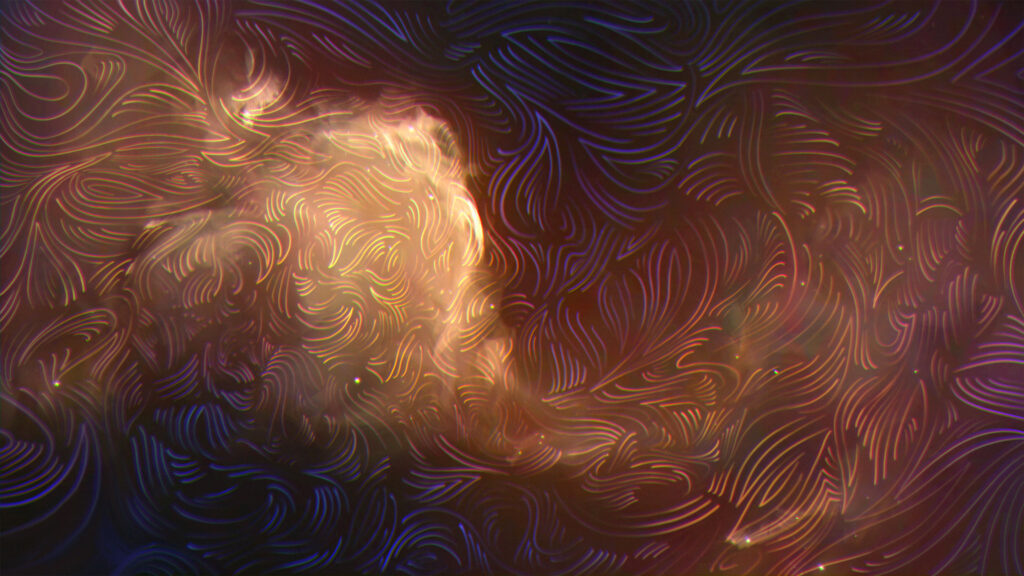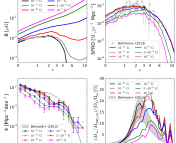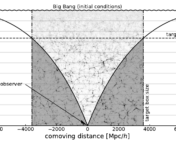Title: Evolution of primordial magnetic fields during large-scale structure formation
Authors: Salome Mtchedlidze, Paola Domínguez-Fernández, Xiaolong Du, Axel Brandenburg, Tina Kahniashvili, Shane O’Sullivan, Wolfram Schmidt, Marcus Brüggen
First Author’s Institution: School of Natural Sciences and Medicine, Ilia State University, 3-5 Cholokashvili St., 0194 Tbilisi, Georgia
Status: open access on arXiv
Magnetic fields are ubiquitous throughout the Universe, playing a part in the physics of planets, stars, galaxies, and beyond. But, where did these magnetic fields come from? Were they born in the Big Bang, or did they arise sometime later in cosmic history? The short answer: we don’t know! This question of cosmic magnetogenesis remains one of the most important unsolved problems in modern astronomy and is intimately connected to the underlying cosmology and fundamental physics of our Universe.

The birth of magnetic fields
Very broadly speaking, there are two competing avenues for cosmic magnetogenesis: the astrophysical scenario and the primordial scenario. In the astrophysical scenario, weak, small-scale magnetic fields are produced around local astronomical systems — like stars and galaxies — and are then amplified and spread across large scales; these initially tiny seed fields could be generated via naturally circulating electric currents (so-called “dynamos”), the turbulent flow of intergalactic or interstellar gas, or spontaneous processes in unstable plasmas. By contrast, magnetic fields in the primordial scenario are generated at the dawn of cosmic time — before stars, galaxies, or any structure in the Universe came to be — and grow with the Universe itself. Hypotheses of primordial magnetogenesis involve highly theoretical quantum phenomena, like the violation of fundamental symmetries of nature or the coupling and decoupling of the fundamental forces. Despite each of the primordial models taking place shortly after the Big Bang, the precise mechanism of field generation is hotly contested.
Nevertheless, the presence of magnetic fields in the early Universe could have vitally important cosmological consequences. For one, these fields would tamper with the cosmic microwave background (CMB) — the oldest, most distant light we can see — fundamentally affecting our inferences of the state of the infant Universe. Primordial magnetic fields would also alter the thermal properties of the material between galaxies, thus shifting the time at which the Universe transitioned from neutral to “reionized.” Recently, it’s even been suggested that early magnetic fields could explain the “Hubble tension” — the notorious mismatch between local and global measurements of the expansion rate of the Universe — and, if these fields are sufficiently twisty (i.e., the fields are helical), they could also explain why the Universe contains so much more matter than antimatter. In other words, figuring out magnetogenesis could solve many of the Universe’s biggest puzzles for the price of one!
Baby photos of the cosmic magnetic field
Evidently, primordial magnetic fields deserve some attention. As such, today’s paper seeks to understand how magnetic fields would evolve from the very early Universe to the present day. In particular, the authors use computer simulations to trace how a primordial seed field would interact with the largest-scale structures in the Universe — the components of the cosmic web, like massive galaxy clusters, long, thin filaments, and vast, empty cosmic voids — as they develop over cosmic time. By comparing current observations of large-scale magnetic fields to the patterns predicted by these simulations, we can rule out different models of primordial magnetogenesis.
The authors consider four different models for the primordial magnetic field: first, a completely uniform and homogeneous field that could be produced during the rapid inflation of the Universe; second, a scale-invariant field (a field possessing equal contributions from waves with small wavelengths and waves with large wavelengths) that could result from a different inflationary scenario; third, a random, non-helical field that could originate from a “phase transition” in the early Universe, when some fundamental force became independent from the rest; and fourth, a random, helical field that could also arise from a phase transition. These scenarios set the initial conditions of the authors’ simulations, and thus each model is expected to evolve in a different way.
Magnetic fields all grown up
Figure 2 shows the imprint of the simulated primordial magnetic fields on the present-day cosmic web with respect to field strength, density, and temperature. The authors find that the two inflationary magnetic field models develop stronger evolved fields than the two phase-transitional models, with the overall magnetization in galaxy clusters and in the bridges between clusters differing by orders of magnitude between the two field-generation scenarios. Additionally, the inflationary magnetic fields stretch to much larger scales than do the phase-transitional cases. While the helical phase-transitional fields evolve to higher strengths than the non-helical fields, the authors note that, at least according to their models, it should be difficult to distinguish between helical and non-helical fields observationally.

The authors also produce simulated maps of the present-day rotation measure (RM) based on the evolved primordial fields (Figure 3). When a radio wave passes through a magnetic field on its way to an observer, its polarization is rotated by an amount proportional to the magnetic field’s strength; therefore, by measuring the degree to which an extragalactic radio wave’s polarization has been affected (quantified by the aptly-named rotation measure) one can deduce the strength of astronomical magnetic fields. By comparing their RM maps to recent observations, the authors find that the two inflationary magnetic field models, which produce larger magnetization levels in cosmic filaments, are favored over the phase-transitional models.

While their modeling of magnetic field evolution over cosmic time neglects some key physical processes, such as gas cooling, chemical evolution, and high-energy outflow from stars and black holes, the authors still decisively show that different models of primordial magnetogenesis leave unique imprints on the Universe’s largest scales. Since LOFAR has already started taking rotation measure data of distant radio waves passing through cosmic filaments, it’s only a matter of time before we can start ruling out models of early magnetic field creation. Even better, when the Square Kilometer Array (SKA) comes online in the next decade, it’ll collect exquisite RM data from the entirety of the cosmic web. With the power of SKA at our disposal, we’ll be solving the mysteries of magnetogenesis
Astrobite edited by: Zili Shen
Featured image credit: Quanta Magazine





is it elementary in the expansion to 44 billion light years at a pico scale
or is it
elementary in the expansion to 44 billion light years on filamentary scales